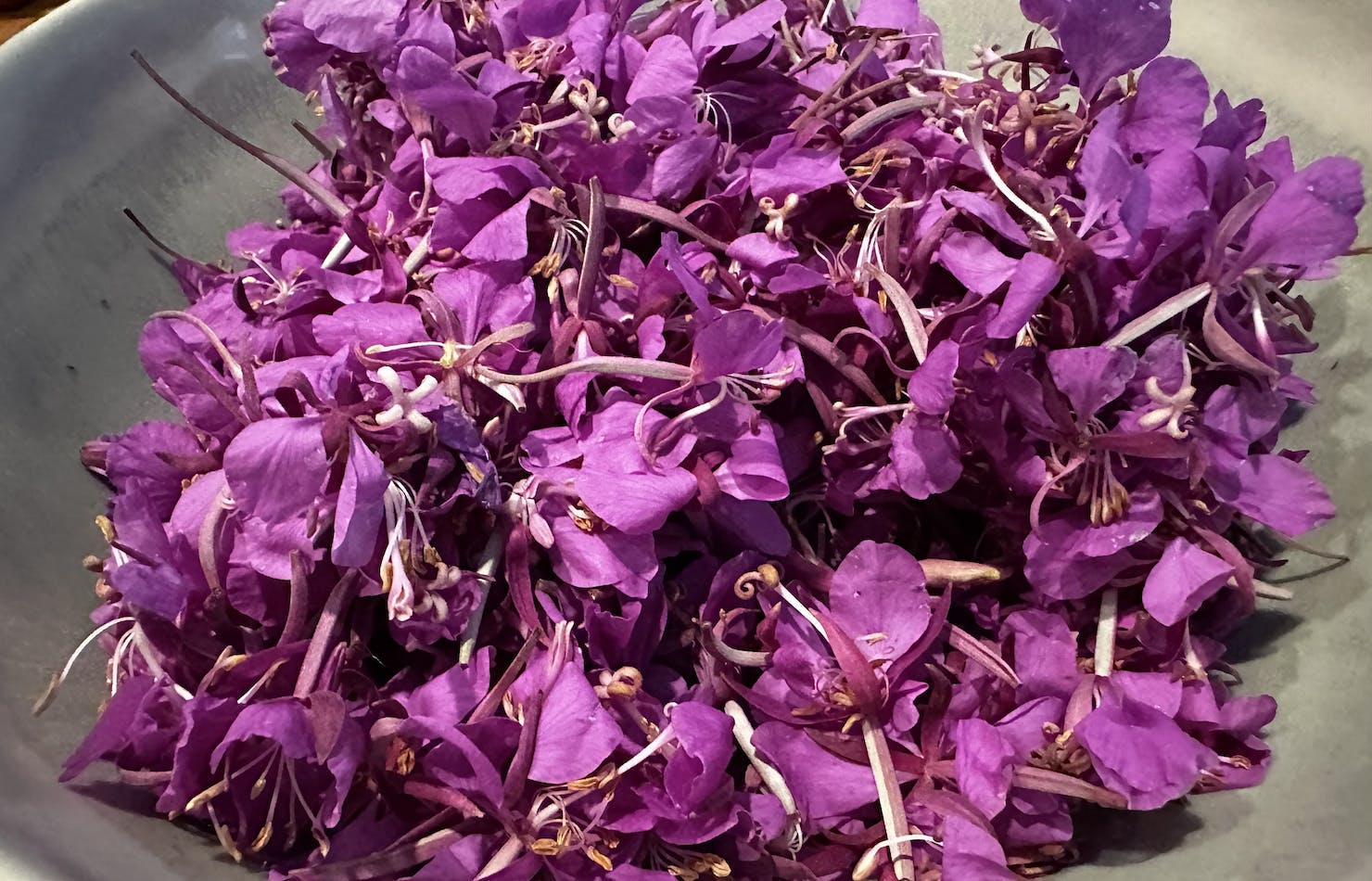
Discovering Fireweed
Fireweed, also known as rosebay willowherb, is a tall and elegant plant that graces landscapes with its striking appearance. Its vivid pink to purple flowers create a breathtaking display during the summer months, painting fields and roadsides with a vibrant hue. Native to North America, Europe, and Asia, fireweed is often the first plant to colonize areas that have been disturbed by wildfires or other natural events, making it a symbol of ecological resilience.
Foraging Ethics and Safety
Before embarking on a fireweed foraging adventure, it's important to understand and adhere to ethical foraging practices. Always ensure you have permission to forage on the land you're exploring, as some areas may have restrictions to protect fragile ecosystems. Fireweed is abundant on roadsides that are often sprayed with chemicals or contaminated by vehicles, so it's always a good idea to steer clear of these types of site when harvesting. Look for fireweed patches in late summer when the flowers are in full bloom. Remember to gather responsibly, taking only what you need and leaving plenty for the ecosystem and other foragers (especially bees!!!) to enjoy.
When harvesting fireweed, follow these guidelines:
Identify Correctly: Be certain that you can accurately identify fireweed. Mistaking it for other plants can be dangerous. Follow these tips:
- Habitat and Location: Fireweed is commonly found in a variety of habitats, including open meadows, roadsides, disturbed areas, and along the edges of forests. It tends to thrive in areas that have been recently cleared by wildfires or other disturbances.
- Stature and Growth: Fireweed is a tall, erect plant that can reach heights of 3 to 8 feet (1 to 2.5 meters). It typically grows in clusters or stands, creating vibrant patches of color in the landscape.
- Leaves: The leaves of fireweed are narrow, lance-shaped, and alternate along the stem. They have a slightly toothed margin and are usually about 2 to 6 inches (5 to 15 cm) in length. The leaves are typically dark green in color.
- Flowers: One of the most striking features of fireweed is its vibrant flowers. The flowers are pink to purple in color, with four petals that are fused at the base to form a tube. They grow in long, vertical clusters along the upper portion of the stem. The flowers gradually open from the bottom of the cluster to the top as they bloom.
- Bloom Time: Fireweed typically blooms from late spring to early fall, depending on the climate and location. The timing of blooming can vary based on factors such as altitude and latitude.
- Seed Pods: As the flowers fade, they are replaced by seed pods that contain numerous small seeds. These pods are long, narrow, and pointed, resembling small capsules.
- Stem: The stem of fireweed is usually reddish or purplish in color and can be covered with fine hairs. It is sturdy and erect, with leaves and flowers branching off from it.
- Winter Appearance: In the winter, fireweed dies back, leaving behind tall, dried stems. These stems can persist through the colder months and are often easily recognizable due to their height and the remnants of seed pods.
Harvest Responsibly & Respect the Environment: Only take what you need and avoid over-harvesting. Leave enough plants for wildlife and other foragers. Stay on designated paths and trails to minimize your impact on the ecosystem. Avoid damaging plants, soil, and habitats.
Stay Hydrated and Safe: Foraging can be physically demanding, so bring plenty of water, wear appropriate clothing, and be cautious of ticks, poison ivy, or other hazards.
Culinary Delights: Fireweed in the Kitchen
Fireweed isn't just a pretty face; it offers a range of culinary possibilities too. Here are some creative ways to incorporate fireweed into your meals:
- Fireweed Jelly: The delicate flavor of fireweed flowers can be captured in a delightful jelly. Pair it with cheese, spread it on toast, or use it as a glaze for meats. Check below for our recipes!!!
- Fireweed Tea: To make this tea, you ferment the leaves of the fireweed plant and dry them. Hank Shaw at Hunt Gather Cook wrote a great post about Fireweed (or Russian tea) on his site Hunt Gather Cook, more information can be found at https://honest-food.net/fireweed-tea-recipe/
- Fireweed Shoots: Young fireweed shoots can be used in salads or cooked as greens. They have a tender texture and a slightly tangy flavour. Once the plant has started flowering though, the leaves are going to be too tough and bitter to be enjoyable and are better considered a survival food at this point.
- Fireweed Honey: Infuse honey with fireweed flowers to add a unique floral twist to your sweetener.
Medicinal Uses: Fireweed's Healing Touch
Fireweed has a history of traditional medicinal use among indigenous cultures. While its medicinal properties haven't been extensively studied, it's believed to offer potential benefits:
- Digestive Aid: Fireweed leaves are thought to have mild digestive properties and may be used as a soothing tea for gastrointestinal discomfort.
- Anti-Inflammatory: Some people use fireweed topically for its potential anti-inflammatory properties, often in the form of poultices or salves.
- Respiratory Support: Fireweed tea might offer relief for minor respiratory issues due to its potential expectorant properties.
A Final Word of Caution
Although fireweed has a long history of traditional use, it's important to consult with a qualified healthcare professional before using it for medicinal purposes, especially if you have pre-existing health conditions, are pregnant, or are taking medications.
Embark on a Fireweed Adventure
Foraging fireweed allows you to connect with nature's bounty in a meaningful and sustainable way. Whether you're capturing its beauty through your camera lens, experimenting in the kitchen, or exploring its potential health benefits, fireweed is a versatile and fascinating plant that invites you to explore the wonders of the natural world. Remember to forage responsibly, respect the environment, and enjoy the journey of discovery that fireweed offers.
Fireweed Jelly Recipe
Ingredients:
- 4 cups of fireweed blossoms
- 4 cups of water
- 1/4 cup of lemon juice
- 1 package of pectin
- 4 cups of granulated sugar
Instructions:
- In a large pot, combine the fireweed blossoms and water. Bring the mixture to a boil, then reduce the heat and let it simmer for about 15 minutes.
- Remove the pot from heat and strain the liquid through a fine-mesh sieve or cheesecloth, discarding the spent blossoms.
- Return the strained liquid to the pot and stir in the lemon juice and pectin. Bring the mixture to a rolling boil.
- Gradually add the sugar, stirring constantly until it dissolves completely. Continue boiling for another minute.
- Remove the pot from heat and skim off any foam that forms on the surface.
- Pour the hot jelly into sterilized jars, leaving a small headspace. Secure the lids tightly.
Jalapeño Fireweed Jelly
Recipe contributed by Rob Munroe, Helicopter pilot and hunting fanatic.
Ingredients:
- 4 cups of fireweed blossoms
- 1 cup of water (add more as needed when boiling to keep at level amount)
- 1 cup of lemon juice
- 2 packages of pectin
- 1 cup of granulated sugar
- 2 jalapeños
Instructions:
Boil for an hour, but keep adding water as it boils to keep the mixture at a consistent amount. After an hour, strain the flowers out and add two packages of pectin. Stir well and boil one minute longer. Skim any foam off the top and pour jelly into sterilized jars and seal according to manufacturers instructions.


